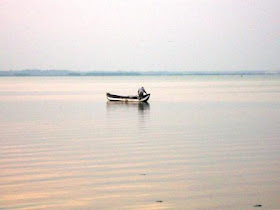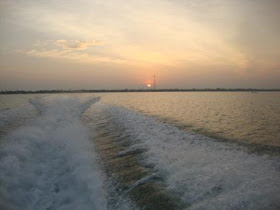
The current state of the bridge construction at this crossing of the Aruvi Aru just south of Mannar.
I went up the Western Road, now open to the public from Colombo, via Puttalam. From there on the road, some parts of which are paved and others dirt, were nevertheless being widened and improved. We passed Vanathavillu, and then nr Eluvankulam we crossed the Kala Oya at which point you enter the Willpattu Park and continuing on this ver dusty trail, we crossed Moderagam Aru at Mullikulum where you leave the park.
You then enter a buffer zone which is now gradually being occupied by farmers who wish to make use of a number of abandoned tanks for paddy cultivation. Continuing on to the next area of revitalized settlements at Sylavaththurai one sees a lot of paddy cultivation and at this time of year much harvesting with combine harvesters of the largest kind.
Just North of here the main road turns inland and though i did not go on it , was told it is being carpeted to a high standard. This road meets the Medawachchiya Mannar Road nr Murunkan which is the current route to Mannar.
We however continued along the coast and hit Arippu where the previous blog entry at the Portugese Fort was described. Shortly thereafter the road was closed to 3 wheel and above, where it meets the Malwatu Oya. At this point the river is called Aruvi Aru. There used to be a ferry service here. A proper bridge is being built now and at present only bicycles and motor bikes ply the route with people going to Mannar to work as it apparently saves about 20km of the distance.
It is only a matter of time after this bridge is built, that the A32 Mannar Pooneryn road is completed and tarred or carperted. One then can go all the way to Jaffna on this route, shaving 100km from the whole distance.
While environmentlalists may frown on this further race to build new roads, this opens up this vast currently sparsely developed area for development. My only concern is that this too will be carved up into small settlements and our manic desire for land is fulfilled, instead of the more productive and profitable, large extended farms or estates where crops can be grown, along with adequate reservations made for National Forests and areas that are demarcated as virgin lands not to be encroached upon. My point is as evidenced in my area, lands given to small farmers eventually get subdivided and become homesteads creating a country of villas and not productive agriculture.
Before any allocation of lands it is important that a national policy be adopted with regard to opening up lands. and strictly adhered to. I am afraid once the horse has bolted the enviros and others will try to close the stable door. So before it is upon us do something now as we always wait till its too late to try and reverse decisions, without first evaluating the decisions at the time they are made. People complain they are made in secret, but there are ways to find out impeding decisions if one is on the ball.

Aruvi Aru shortly before it flows into the sea just south of Mannar



































